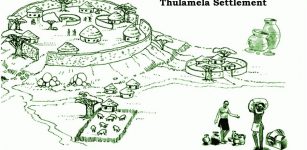Egyptians Mastered Medicine Thousands Of Years Ago
A. Sutherland - AncientPages.com - Civilization in Ancient Egypt means tombs, pyramids, and all aspects of human life. Prehistoric physicians in Egypt had an impressive knowledge of the human body, its inner workings, and the treatment of illness and disease.
An invocation to I-em-hetep, the Egyptian deity of medicine. Oil painting by Ernest Board. Image credit: wellcomecollection.org
Egyptian medical papyri documented many diagnostics and medical achievements we still use today.
The Egyptians' medicine reached a very high standard, spreading its reputation to neighboring countries.
Complementary medicine, like herbal medicine, played a key role in society. Ancient Egyptian scrolls document natural herbs and holistic medicine that saved lives and cured disease.
Proof comes from burial sites, tombs, and underground temples where archeologists have found extensive sets of medical documents and scrolls, including the Ebers Papyrus, the Edwin Smith Papyrus, the Hearst Papyrus, and the London Medical Papyrus, which contained the earliest documented awareness of tumors.
The Ebers Papyrus is the most famous plant-medicine "encyclopedia". It is a 110-page scroll that is about 20 meters long.
Egyptians consumed raw garlic and onions for endurance and to heal asthma and bronchial-pulmonary issues. Many of their herbs were steeped in wine and used as oral medicine.
These were natural herbs, untainted by pesticides, herbicides, insecticides, or fluoridated water.
The Egyptians documented using myrrh, frankincense, fennel, cassia, thyme, juniper, and aloe. Fresh garlic cloves were peeled, mashed, and macerated in vinegar and water and used as a rinse for sore throats and toothaches.
They knew about the healing powers of honey. The first official recognition of the importance of honey dates back to the first Egyptian Dynasty and the "Sealer of the Honey."
In Niuserre's Sun temple, beekeepers are shown in hieroglyphics blowing smoke into hives as they remove honeycombs.
Herbal medicine was mastered thousands of years ago.
Inscription detailing ancient Egyptian medical instruments, including bone saws, suction cups, knives and scalpels, retractors, scales, lances, chisels and dental tools.
Image credit: Jeff Dahl - CC BY-SA 2.5 DEED
The honey was immediately jarred and sealed and could, therefore, be kept for years, and it was used to produce medicines and ointments. They even used it as a natural antibiotic. The mainland for bee-keeping was in Lower Egypt, where extensive irrigation fed thousands of flowering plants. The bee was chosen as a symbol for the country, and the gods were associated with the bee.
One pharaoh's title was Bee King, and his Royal archers protected the bees like they were his holy temple. The temples were homes for the bees to satisfy the gods' desires.
Canaan was called the "Land of Milk and Honey" in the Hebrew tradition.
Egyptian medicine is some of the oldest ever documented. From the 33rd century BC until the Persian invasion in 525 BC, Egyptian medical practice remained consistent in its highly advanced methods for the time.
Homer even wrote in the Odyssey: "In Egypt, the men are more skilled in medicine than any of humankind," and "The Egyptians were skilled in medicine more than any other art."
The papyrus contains a "treatise on the heart," which recognizes the heart as the center of the blood supply, with vessels attached.
Even mental disorders, depression, and dementia were detailed in one of the chapters. The Egyptians were treating intestinal disease and parasites, eye and skin problems, abscesses, and tumors. Remedies from the ancient Ebers Papyrus scrolls:
o Aloe vera was used to alleviate burns, ulcers, skin diseases, and allergies
o Basil was written up as a heart medicine
o Balsam Apple (Apple of Jerusalem) was used as a laxative and as a liver stimulant
o Bayberry was prescribed for diarrhea, ulcers, and hemorrhoids
o Caraway soothed digestion and was a breath freshener
o Colchicum (citrullus colocynthus or meadow saffron) soothed rheumatism and reduced swelling
o Dill was recognized for laxative and diuretic properties
o Fenugreek was prescribed for respiratory disorders and to cleanse the stomach and calm the liver and pancreas
o frankincense was used for throat and larynx infections and to stop bleeding and vomiting
o garlic was given to the Hebrew enslaved people daily to give them vitality and strength for building the pyramids
o Licorice was utilized as a mild laxative to expel phlegm and alleviate chest and respiratory problems
o Onion was taken to prevent colds and to address cardiovascular problems (How did they know?)
o Parsley was prescribed as a diuretic
o thyme was given as a pain reliever and Tumeric for open wounds
o Poppy was used for relieving insomnia, as an anesthetic, and to deaden the pain
o Coriander was taken as a tea for urinary complaints, including cystitis
o Pomegranate root was strained with water and drunk to address "snakes of the belly" (tapeworms). The alkaloids contained in pomegranate paralyzed the worms' nervous system, and they relinquished their hold.
o Persian henna was used against hair loss. The disease was not uncommon in Ancient Egypt. There were many skin afflictions and parasites from the Nile River waters. Worms and tuberculosis were common, sometimes transmitted from cattle. Pneumonia struck people who breathed too much sand into their lungs during sand storms.
Updated on December 16, 2023
Copyright © AncientPages.com All rights reserved. This material may not be published, broadcast, rewritten or redistributed in whole or part without the express written permission of AncientPages.com
Expand for referencesSandison, A.T. "Diseases in Ancient Egypt"
More From Ancient Pages
-
 Saint George: Knight Warrior Who Refused To Denounce His Faith And Died A Martyrs Death
Featured Stories | Jun 3, 2019
Saint George: Knight Warrior Who Refused To Denounce His Faith And Died A Martyrs Death
Featured Stories | Jun 3, 2019 -
 Enormous And Impressive Derawar Fort, Bahawalpur, Pakistan Will Be Restored
News | Sep 14, 2015
Enormous And Impressive Derawar Fort, Bahawalpur, Pakistan Will Be Restored
News | Sep 14, 2015 -
 Florentine Codex: Remarkable Manuscripts About Life Of The Aztecs
Ancient History Facts | Nov 15, 2016
Florentine Codex: Remarkable Manuscripts About Life Of The Aztecs
Ancient History Facts | Nov 15, 2016 -
 Årsgång – Year Walk In The Forest – Mystical Journey To Gain Knowledge About The Future – An Ancient Swedish Ritual
Ancient Traditions And Customs | Jan 2, 2019
Årsgång – Year Walk In The Forest – Mystical Journey To Gain Knowledge About The Future – An Ancient Swedish Ritual
Ancient Traditions And Customs | Jan 2, 2019 -
 World’s Oldest Paycheck Reveals Ancient Sumerian Workers Were Paid In Beer
Ancient History Facts | Nov 22, 2018
World’s Oldest Paycheck Reveals Ancient Sumerian Workers Were Paid In Beer
Ancient History Facts | Nov 22, 2018 -
 ‘Aerial Cemetery’ – Ancient Tradition Of ‘Hanging Coffins’
Ancient Traditions And Customs | Sep 9, 2018
‘Aerial Cemetery’ – Ancient Tradition Of ‘Hanging Coffins’
Ancient Traditions And Customs | Sep 9, 2018 -
 Use Of Tobacco Pipes By Hopewell People Tells A New Story
Archaeology | Jun 28, 2021
Use Of Tobacco Pipes By Hopewell People Tells A New Story
Archaeology | Jun 28, 2021 -
 10 Incredible And Bizarre Ancient Cases Of Mass Hysteria
Featured Stories | Jul 14, 2015
10 Incredible And Bizarre Ancient Cases Of Mass Hysteria
Featured Stories | Jul 14, 2015 -
 Impressive And Rare Hoard Of Silver Coins Dated To The Hasmonean Period (126 BC) – Studied
Archaeology | Oct 14, 2021
Impressive And Rare Hoard Of Silver Coins Dated To The Hasmonean Period (126 BC) – Studied
Archaeology | Oct 14, 2021 -
 Stunning Well-Preserved Larger Than Life Statue Of Hercules Discovered In Philippi, Greece
Archaeology | Sep 24, 2022
Stunning Well-Preserved Larger Than Life Statue Of Hercules Discovered In Philippi, Greece
Archaeology | Sep 24, 2022 -
 Artificial Intelligence And Clay Tablets: Not Yet A Perfect Match
Scripts, Paintings & Inscriptions | Oct 12, 2023
Artificial Intelligence And Clay Tablets: Not Yet A Perfect Match
Scripts, Paintings & Inscriptions | Oct 12, 2023 -
 On This Day In History: Sir Thomas Brisbane, Astronomer, Soldier And Governor Was Born – On July 23, 1773
News | Jul 23, 2016
On This Day In History: Sir Thomas Brisbane, Astronomer, Soldier And Governor Was Born – On July 23, 1773
News | Jul 23, 2016 -
 Motilla del Azuer: Impressive And Unusual 3,200-Year-Old Fortress
Featured Stories | Nov 13, 2018
Motilla del Azuer: Impressive And Unusual 3,200-Year-Old Fortress
Featured Stories | Nov 13, 2018 -
 Wars Of The Roses: Thirty Two Years Of Struggle To Claim English Throne
Featured Stories | Aug 5, 2017
Wars Of The Roses: Thirty Two Years Of Struggle To Claim English Throne
Featured Stories | Aug 5, 2017 -
 What Happened To The Staircase In The Temple Of The Goddess Hathor?
Civilizations | Mar 9, 2017
What Happened To The Staircase In The Temple Of The Goddess Hathor?
Civilizations | Mar 9, 2017 -
 Ancient Petroglyph Code Cracked By Archaeological Explorers
News | Apr 10, 2020
Ancient Petroglyph Code Cracked By Archaeological Explorers
News | Apr 10, 2020 -
 Anchor Church Caves – Has The Home Of Anglo-Saxon King Eardwulf And Saint Hardulph Been Found?
Archaeology | Jul 23, 2021
Anchor Church Caves – Has The Home Of Anglo-Saxon King Eardwulf And Saint Hardulph Been Found?
Archaeology | Jul 23, 2021 -
 Anartes: Forgotten Celtic Tribe And The Hercynian Forest With Strange Animals
Featured Stories | Jun 18, 2024
Anartes: Forgotten Celtic Tribe And The Hercynian Forest With Strange Animals
Featured Stories | Jun 18, 2024 -
 Enigmatic Ancient Kingdom Of Thulamela Created By Mysterious Shona People
Civilizations | Dec 28, 2016
Enigmatic Ancient Kingdom Of Thulamela Created By Mysterious Shona People
Civilizations | Dec 28, 2016 -
 Hoards Of Viking Coins Discovered On The Island Of Saaremaa
Archaeology | Oct 7, 2019
Hoards Of Viking Coins Discovered On The Island Of Saaremaa
Archaeology | Oct 7, 2019




